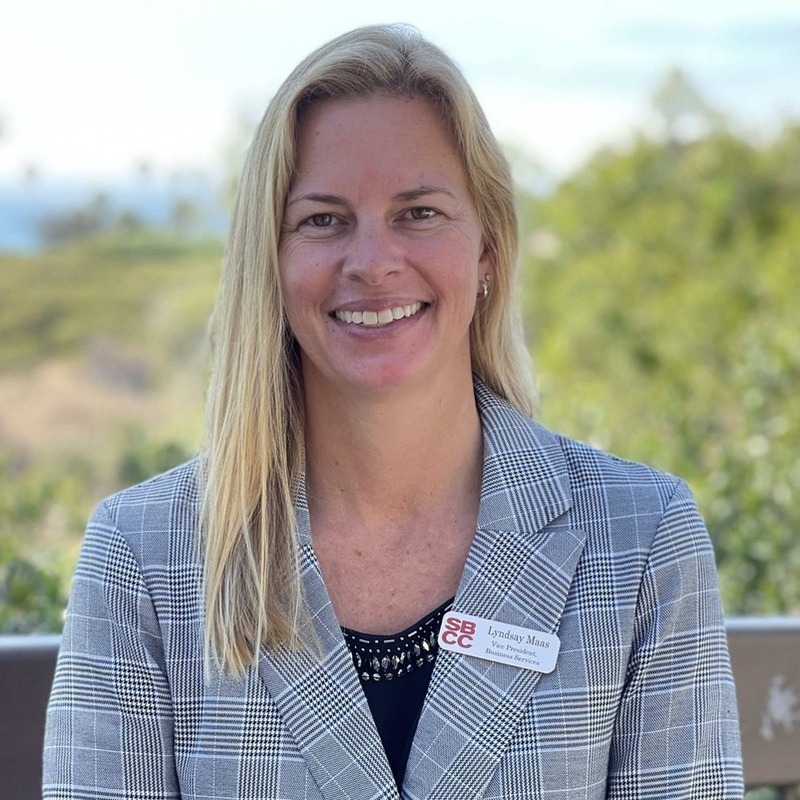Lyndsay Maas is a driven and accomplished professional with an extensive career in finance and business administration. Armed with an impressive academic background, she holds a Master’s of Business Administration from California State University Channel Islands.
Early in her career, Lyndsay honed her skills and expertise in the private finance sector, where she managed large corporate accounts and built strong client relationships. Her team management and process optimization proficiency set her apart, making her a valuable asset in the financial world.

However, an exciting opportunity led Lyndsay to pivot her career into the public sector, joining Santa Barbara City College. She displayed exceptional leadership and strategic insight during her three years as the Controller. Her transition to the role of Vice President of Business Services showcased her ability to introduce innovative ideas from the private sector into a public institution, leading to the optimization of various processes within the college.
Lyndsay’s aptitude for handling substantial budgets and accounts became evident during her tenure at Santa Barbara City College. As the top managerial accountant, she skillfully managed the college’s general budget of $105 million. Lyndsay successfully oversaw multiple teams, streamlined operations, and efficiently allocated funds, ensuring the smooth execution of annual audits.
Her tenure as Vice President of Business Services presented her with new challenges and opportunities to demonstrate her managerial prowess. Lyndsay deftly navigated personnel changes while overseeing crucial departments, implementing cost-saving measures, and simplifying existing teams. Additionally, she successfully managed significant events and projects, including constructing a new classroom building and planning for a new Physical Education Building, all while ensuring the seamless execution of the annual 4th of July celebration.
Lyndsay Maas holds the esteemed position of Assistant Finance Director with the City of Santa Barbara. In this role, she brings her municipal and government accounting expertise to the forefront. Responsible for treasury, investments, revenues, utility billing, cash receipts, and accounts receivable, Lyndsay plays a crucial role in ensuring the city’s financial stability and growth.
Outside her thriving professional career, Lyndsay Maas is a vibrant individual with diverse interests. As a single mom, she embraces the joy of learning and actively engages in DIY projects around her home. A passionate advocate for environmental preservation, she finds solace and happiness in nature, especially on the water. Her love for water activities such as wakeboarding and waterskiing is evident as she spends quality time with her family on her boat.
Furthermore, Lyndsay believes in nurturing her physical well-being and makes time for exercise, whether it’s trail running in nearby parks or practicing pilates. Her determination to balance a successful career with a fulfilling personal life is a testament to her exceptional dedication and zest for life.
Financial Planning for Small Businesses: Key Steps to Ensure Long-Term Growth
For small businesses, financial planning is a critical aspect that lays the foundation for long-term growth and success. In the competitive and ever-changing business landscape, effective financial management can be the difference between thriving and merely surviving.
1. Set Clear Goals and Objectives
The first step in financial planning for small businesses is to establish clear and realistic goals and objectives. These goals could include revenue targets, profitability margins, expansion plans, or debt reduction targets. Having well-defined goals provides a roadmap and helps in making informed financial decisions aligned with the business’s long-term vision.
2. Create a Detailed Budget
A comprehensive budget is the cornerstone of effective financial planning. It involves estimating income, expenses, and cash flow projections for a specific period, typically a year. By understanding the financial inflows and outflows, businesses can identify areas for cost optimization, plan investments, and ensure that resources are allocated efficiently.
3. Build an Emergency Fund
Unexpected events and economic downturns are inevitable in the business world. To safeguard against financial shocks, small businesses should prioritize building an emergency fund. This reserve of cash can help the business stay afloat during challenging times and prevent the need to take on debt or make drastic cost-cutting decisions that may negatively impact growth.
4. Monitor and Manage Cash Flow
Maintaining a healthy cash flow is vital for the survival and growth of small businesses. Regularly monitor cash flow statements to understand the timing of cash inflows and outflows. Implement strategies to accelerate receivables and optimize payables. Managing cash flow effectively ensures that the business has enough liquidity to cover operational expenses and invest in growth opportunities.
5. Control Costs and Expenses
Cost control is a fundamental aspect of financial planning for small businesses. Identify areas where expenses can be reduced or optimized without compromising the quality of products or services. Negotiate with suppliers for better deals, explore technology to automate processes and streamline operations, and continuously review the cost structure for potential savings.
6. Manage Debt Wisely
Debt can be both a tool for growth and a burden on the business. When using debt as leverage, it’s essential to do so wisely and prudently. Before taking on debt, assess the ability to repay it, consider the impact on cash flow, and analyze the potential return on investment from using borrowed funds. Minimizing high-interest debts and managing debt repayments diligently is crucial to maintain financial stability.
7. Invest in Growth Opportunities
Financial planning is not just about managing expenses; it also involves strategically investing in growth opportunities. Assess areas where the business can expand, such as launching new products, entering new markets, or investing in marketing and sales initiatives. Calculated investments can yield substantial returns and accelerate the business’s long-term growth trajectory.
8. Regularly Review and Adjust the Plan
Financial planning for small businesses is not a one-time exercise. It requires regular review and adjustments to stay relevant and effective. As the business landscape evolves and circumstances change, the financial plan should adapt accordingly. Stay updated on industry trends, economic conditions, and tax regulations that may impact the business’s financial position.
9. Seek Professional Guidance
Financial planning can be complex, especially for small business owners who may not have extensive financial expertise. Seeking professional guidance from accountants, financial advisors, or business consultants can provide valuable insights and help navigate complex financial decisions.
10. Foster a Financially Literate Culture
Finally, promote financial literacy and awareness among employees. When team members understand the company’s financial goals and the impact of their actions on the bottom line, they are more likely to make decisions that align with the business’s long-term growth objectives.
Financial planning is a fundamental aspect of managing a small business, setting the stage for sustainable growth and success. By setting clear goals, creating detailed budgets, managing cash flow, controlling costs, and making informed investment decisions, small businesses can navigate challenges and seize opportunities for long-term prosperity. With continuous monitoring, periodic reviews, and professional guidance, small business owners can confidently steer their ventures toward a brighter financial future. Proactive financial planning today paves the way for a prosperous tomorrow.
